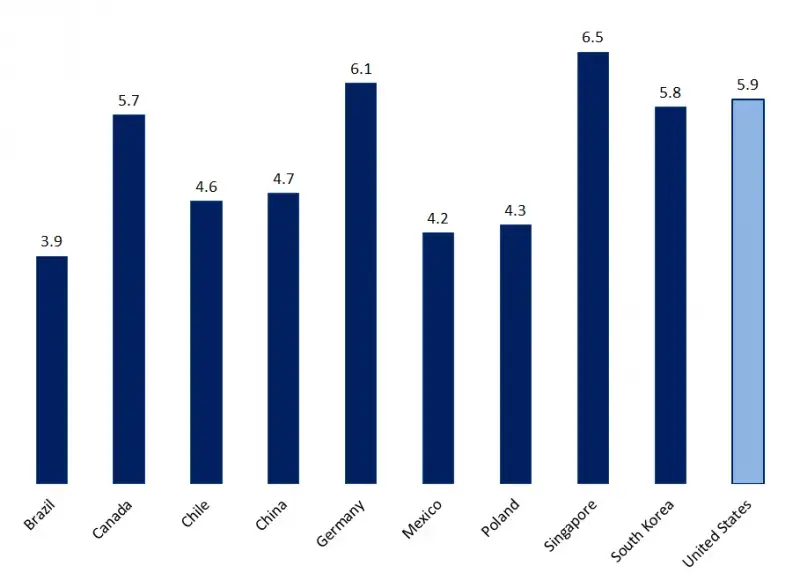Line haul rates: Everything you need to know about Linehaul Cost and Prices
If you are a shipper or a carrier, you may have heard of the term “line haul” and wondered what it means and how it affects your freight costs and prices. Line haul rates are charged by the Linehaul office for moving freight from one point to another, usually over long distances.
Line haul rates are calculated based on the average weight of the freight and the distance traveled. Line haul rates can vary depending on the mode of transportation, the type of freight, the season, the fuel cost, the demand and supply, and the origin and destination of the freight. In this article, we will explain everything you need to know about line haul rates.
By the end of this article, you will have a better understanding of line haul rates and how they impact your freight costs and prices. You will also learn some tips and best practices on how to manage and optimize your line haul transportation and achieve your logistics and supply chain goals.
Different types of line haul rates
Line haul rates are the charges for transporting freight from one point to another, usually over long distances. Line haul rates are calculated based on the average weight of the freight and the distance traveled. There are different types of line haul rates, depending on the mode of transportation and the type of freight. Some of the common types of line haul rates are:
- Truckload (TL) rates:
These are the rates for transporting a full truckload of freight, typically between 20,000 and 45,000 pounds, using a single truck and trailer. TL rates are usually higher than other types of line haul rates, as they offer faster and more direct service, and require less handling and loading of the freight. TL rates may vary depending on the type of truck and trailer, the season, the fuel cost, the demand and supply, and the origin and destination of the freight.
- Less-than-truckload (LTL) rates:
These are the rates for transporting a partial truckload of freight, typically between 150 and 20,000 pounds, using multiple trucks and trailers. LTL rates are usually lower than TL rates, as they allow shippers to share the truck space and the cost with other shippers, and use the carrier’s network of terminals and hubs. LTL rates may vary depending on the weight, size, class, and density of the freight, the distance traveled, the number of stops, and the accessorial services required.
- Intermodal rates:
These are the rates for transporting freight using more than one mode of transportation, such as rail, road, air, or water. Intermodal rates are usually lower than TL rates, as they offer lower fuel costs, higher capacity, and lower environmental impact. Intermodal rates may vary depending on the mode of transportation, the type of container, the distance traveled, the origin and destination of the freight, and the accessorial services required.
How do I calculate line haul rates for my freight?
To calculate line haul rates for your freight, you need to know the following information:
- The origin and destination zip codes of your freight
- The weight and class of your freight
- The tariff rate for your freight class and weight
The tariff rate is the charge per hundred pounds of freight, which varies depending on the freight class and weight. You can find the tariff rate for your freight class and weight using a freight rate calculator.
Once you have this information, you can use the following formula to calculate the line haul rate for your freight:
Line haul rate = (Weight / 100) x Tariff rate
For example, if your freight weighs 500 pounds, has a class of 50, and has a tariff rate of $20 per hundred pounds, the line haul rate for your freight is:
Line haul rate = (500 / 100) x 20 Line haul rate = 5 x 20 Line haul rate = $100
This means that the line haul charge for your freight is $100, excluding any additional fees or surcharges.
Factors that affect linehaul rates
Some of the factors that affect line haul rates are:
- Supply and demand:
The amount of freight that needs to be moved versus the amount of capacity available will make a difference to your freight costs no matter where you are. If there is an influx of freight coming out of a certain region and not enough trucks to cover that freight, the average freight costs go up. The opposite can happen too, if there are more trucks available than freight, the rates will go down. A common reason for this is seasonal demand, such as fall harvest or Christmas trees coming out of the Pacific Northwest, which will see increased rates to get things shipped on time. But other factors, such as a global pandemic, can play a part too
- Mode of transportation:
The mode of transportation that you choose for your freight, such as road, rail, air, or water, will also affect the line haul rates. Each mode has its advantages and disadvantages, such as speed, cost, reliability, and environmental impact. For example, intermodal transportation, which uses more than one mode of transportation, may offer lower fuel cost, higher capacity, and lower environmental impact, but may also take longer and require more handling and loading of the freight
- Type of freight:
The type of freight that you ship will also influence the line haul rates, as different types of freight have different requirements and specifications. For example, the weight, size, class, and density of the freight will determine the tariff rate, which is the charge per hundred pounds of freight. The tariff rate varies depending on the freight class and weight, and you can find it using a freight rate calculator, such as this one. Other factors, such as the value, fragility, or hazardous nature of the freight, may also affect the line haul rates, as they may require special handling, insurance, or permits
- Origin and destination:
The origin and destination of your freight will also have an impact on the line haul rates, as they may involve different distances, routes, and regulations. For example, longer hauls may cost more in total, but less per mile, than shorter hauls. The route that your freight takes may also affect the fuel cost, the traffic, the weather, and the availability of trucks. The origin and destination of your freight may also involve different rules and standards for safety, security, taxation, and customs clearance, which may add to the line haul rates
Tips to Optimize Line Haul Rates
To optimize your line haul rates, you can try some of the following tips:
- Plan and book early:
If you give your transportation provider advance notice, they can preschedule the transportation at a lower cost and get it to the pickup destination on time. However, if the transportation provider gets less than a 12-hour notice, that usually comes at a premium so they can re-maneuver the right truck to get to your pickup location. Booking early also gives you more options and flexibility to choose the best mode of transportation, the best carrier, and the best route for your freight
- Compare and negotiate:
You can use online tools, such as this one, to compare and contrast different line haul rates from different carriers and modes of transportation. You can also negotiate with your transportation provider to get the best deal for your freight, based on your budget, your timeline, and your requirements. You can also leverage your volume, your frequency, and your relationship with your transportation provider to get better rates and discounts
- Consolidate and optimize:
You can also reduce your line haul rates by consolidating and optimizing your freight. For example, you can combine multiple smaller shipments into one larger shipment, which may lower the tariff rate and the number of trucks needed. You can also optimize the weight, size, class, and density of your freight, which may lower the tariff rate and the fuel cost. You can also optimize the origin and destination of your freight, by choosing a seller that is located closer to your country, or that has a local warehouse in your country, which may reduce the distance and the transit time of your freight
Frequently Asked Questions
Here are four possible FAQs related to line haul rates:
- What is the difference between line haul and drayage?
Line haul is the transportation of freight over long distances, typically between different modes of transportation, such as road, rail, air, or waterways. Drayage is the transportation of freight over short distances, typically within the same mode of transportation, such as from a port to a warehouse, or from a warehouse to a rail yard. Line haul and drayage are both important parts of the intermodal transportation process, which involves moving freight using more than one mode of transportation.
- How can I find the best line haul rates for my freight?
You can find the best line haul rates for your freight by using online tools, such as [this one], which can compare and contrast different line haul rates from different carriers and modes of transportation. You can also negotiate with your transportation provider to get the best deal for your freight, based on your budget, your timeline, and your requirements. You can also leverage your volume, your frequency, and your relationship with your transportation provider to get better rates and discounts.
- How can I reduce my line haul costs and save money on my freight transportation?
You can reduce your line haul costs and save money on your freight transportation by consolidating and optimizing your freight. For example, you can combine multiple smaller shipments into one larger shipment, which may lower the tariff rate and the number of trucks needed. You can also optimize the weight, size, class, and density of your freight, which may lower the tariff rate and the fuel cost. You can also optimize the origin and destination of your freight, by choosing a seller that is located closer to your country, or that has a local warehouse in your country, which may reduce the distance and the transit time of your freight.


